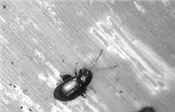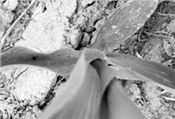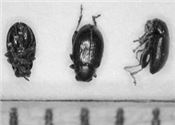Damage By Corn Flea Beetles In Seedling
DR. RAUL T. VILLANUEVA
PRINCETON, KY.
An absence of rains for almost 2 weeks in western Kentucky allowed the increase in populations of some secondary pests in field corn. One of these insects is the corn flea beetle. Commercial and experimental corn fields have been observed with damage caused by the feeding of these jumping critters. Adult flea beetles cause damage feeding on upper or lower leaf surfaces. They remove plant tissue layers parallel to the veins, causing elongated scratch marks or small circular holes on the leaves. (Figures 1 & 2).
Although, high numbers of flea beetles appear serious in seedlings; usually plants recover. However, the damage caused by this insect is economically important when plants are shorter than 6 inches tall and transmission of Pantoea stewartii (formerly Erwinia stewartii) occurs. Pantoea stewartii is a bacterium pathogen that causes Stewart’s disease in corn. This disease is commonly known as Stewart’s wilt or bacterial leaf blight. The bacterium is more efficiently acquired and transmitted by flea beetles than other Coleopteran pests. Plants infected as seedlings often die, and stunted survivors suffer yield loss or produce no ears at all.
Description of Corn Flea Beetles
There are several species of flea beetle that feed on corn; however, the corn flea beetle Chaetocnema pulicaria (Coleoptera: Chrysomelidae) is the species most frequently found in corn. This is a minute-sized black shiny beetle (2 mm or 1/12 inch in length) with thickened hind legs used to leap considerable distances when disturbed (Figure 3). Corn flea beetle overwinters as an adult just below the soil surface in grassy areas near cornfields. In Kentucky, they can be present from mid-April to August when adults move to corn after plants emerge. Many grass species are hosts for corn flea beetles. Adults oviposit on the soil surface. This insect can have several generations per year.
Scouting & Management
In Kentucky, there are recommendations for scouting when plants are shorter than 12 inches; and the following rating scale for damages is provided: 0 (no damage or scratch marks); 1 (scattered scratch marks on less than 50 percent of the plants; plants appear healthy), 2 (feeding on new leaves of 50 percent or more of the plants; some leaves whitish) and 3 (leaves turning brown, plants dying).
Systemic seed treatments may provide early season control of corn flea beetle and Stewart’s wilt in corn. In fields that have historical records of Stewart’s wilt, labeled pyrethroids products may be used.
In addition, cultural practices, such as use of hybrid corn resistant to the disease and reduction of grasses where the beetle can overwinter or use as alternative food sources for larvae and adults, can reduce corn flea beetle populations. ∆
DR. RAUL T. VILLANUEVA: Extension Entomologist, University of Kentucky

Photos: Raul Villanueva, UK
Figure 2. Corn flea beetle and the damage it caused on a corn leaf.

Figure 1. Flea beetle damage to lower leaf of seedling corn; note the elongated white patches parallel to veins.

Figure 3. Ventral, dorsal, and lateral view of the corn flea beetle (space between lines under image are in measurements
in millimeters). Notice the thickened hind leg (dorsal view image) showing the highly specialized thickened femur enabling it to make leaps when disturbed.